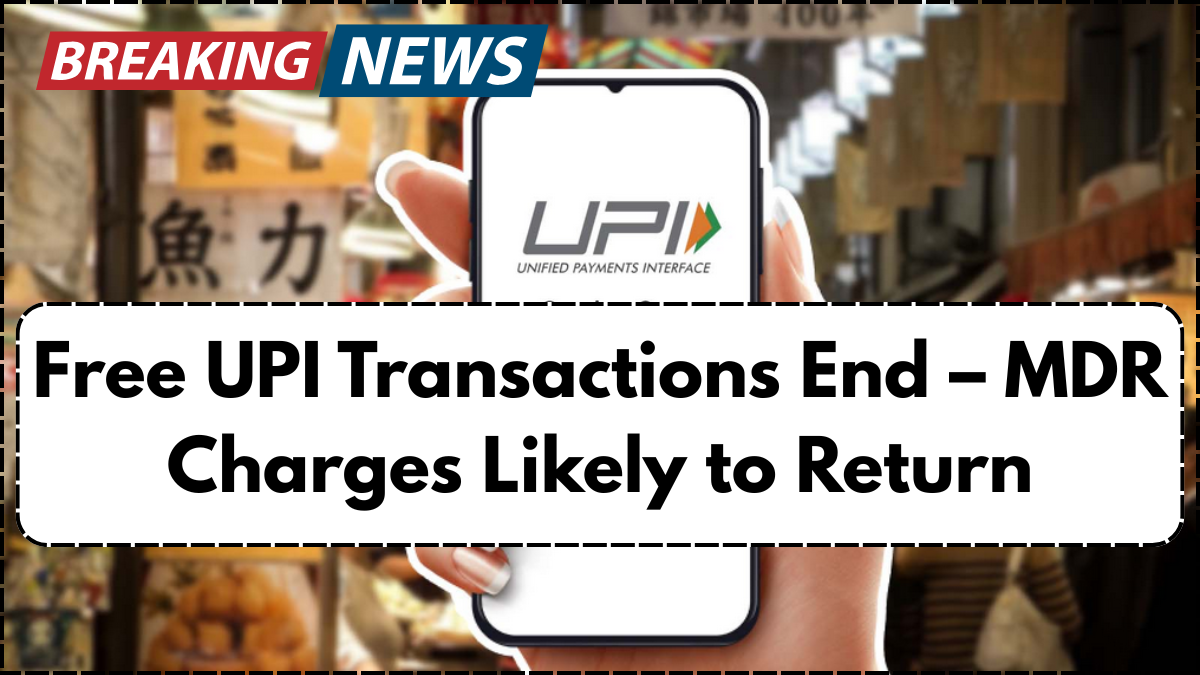Unified Payments Interface (UPI) has been the cornerstone of India’s digital payments ecosystem, enabling millions to perform instant, secure, and cost-free money transfers. However, this fee-free structure may soon change. As of May 2025, the Payments Council of India (PCI) has formally proposed reinstating the Merchant Discount Rate (MDR) on UPI and RuPay transactions. This move comes amidst mounting pressure on financial institutions to ensure long-term viability without relying heavily on government subsidies.

What is UPI?
UPI, developed by the National Payments Corporation of India (NPCI), is a real-time payment system that facilitates seamless bank-to-bank transfers using mobile platforms. Instead of juggling multiple apps and banking platforms, users can make transactions through a single interface, making the process fast, simple, and highly efficient.
Key Features of UPI
- Real-time inter-bank fund transfers
- Currently zero transaction fees for users and merchants
- Integrated with platforms like PhonePe, Google Pay, Paytm, and banking apps
- High-end security through two-factor authentication
In February 2025, UPI processed over 16 billion transactions, with a total value of nearly ₹22 lakh crore, highlighting its massive adoption.
Were UPI Transactions Always Free?
No. Until the end of 2019, UPI transactions included MDR fees. In December 2019, Finance Minister Nirmala Sitharaman declared that MDR fees would be waived on UPI and RuPay debit card payments, starting January 1, 2020.
Before this decision, merchants typically paid less than 1% per transaction. This fee was distributed among banks, payment gateways, and fintech operators. To compensate for the revenue loss, the government allocated subsidies to service providers. However, with these subsidies drastically reduced in FY25, the industry is pushing for a return to the MDR model.
What is Merchant Discount Rate (MDR)?
MDR is the fee that merchants pay to banks and payment service providers for handling digital transactions. Here’s a comparison table for clarity:
| Payment Method | MDR Rate (Before Jan 2020) | Current MDR Rate (May 2025) |
|---|---|---|
| Credit Cards | 1% – 3% | 1% – 3% |
| Debit Cards | 0.5% – 1% | 0.5% – 1% |
| UPI Transactions | <1% | 0% |
| RuPay Debit Cards | <1% | 0% |
To illustrate: if a merchant receives ₹5,000 via credit card with a 2% MDR, they must pay ₹100 in processing fees. In contrast, UPI transactions currently incur no such cost, making them highly attractive for businesses.
Why Is There a Push to Reinstate MDR on UPI?
Several industry-driven factors are fueling the advocacy for MDR reintroduction:
Decline in Government Subsidies
The Indian government allocated ₹3,500 crore in FY24 to support zero-MDR systems. For FY25, this budget has been cut to ₹1,500 crore—just 15% of the estimated ₹10,000 crore needed to sustain the UPI framework.
Infrastructure Sustainability
Maintaining a robust digital ecosystem involves constant investment in cybersecurity, fraud monitoring, technology upgrades, and merchant onboarding. Without consistent revenue, service quality and innovation could decline.
Competitive Fairness
Currently, UPI and RuPay offer no revenue to payment facilitators, unlike other modes like credit cards and wallets. A nominal MDR of around 0.3% could help create a more level competitive field while still being affordable.
What Happens If MDR Returns?
The return of MDR fees would impact multiple stakeholders:
Effect on Merchants
- Higher Costs: Merchants would bear additional processing fees, reducing margins.
- Cost Transfer: Some may raise prices or add digital transaction fees for customers.
- Shift to Cash: To avoid MDR, businesses might prefer cash, potentially slowing digital adoption.
Effect on Consumers
- Price Increases: MDR could indirectly inflate retail prices.
- Fewer Digital Options: Retailers may limit UPI use to avoid fees.
Effect on Payment Providers
- Revenue Stability: MDR fees would provide a sustainable income stream.
- Enhanced Services: With new revenue, providers can invest in better user interfaces, support, and fraud protection.
Conclusion
The decision to reintroduce MDR fees on UPI and RuPay is not merely a policy shift but a strategic move aimed at preserving the health of India’s digital payment ecosystem. While it may lead to short-term resistance from merchants and users, it could ultimately foster a more sustainable and innovative financial infrastructure.
FAQ
What is MDR in digital payments?
MDR (Merchant Discount Rate) is a fee merchants pay to service providers for processing digital transactions.
Why are MDR fees being reconsidered now?
Because government subsidies for UPI have been significantly reduced in FY25, leading to calls for a more sustainable revenue model.
Will consumers be charged directly if MDR is reintroduced?
Consumers aren’t typically charged MDR directly, but businesses might pass the cost on through higher prices or added fees.
How much MDR might be applied to UPI transactions?
Industry suggestions are leaning toward a nominal MDR of around 0.3% to ensure affordability while supporting infrastructure.
Could this slow down digital payment adoption?
Possibly. If fees are perceived as high, merchants may shift back to cash, especially in low-margin sectors.
For More Information Click Here



